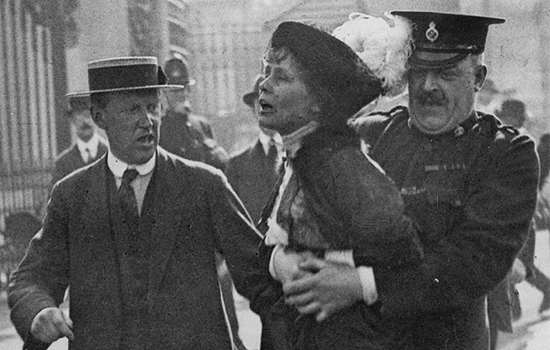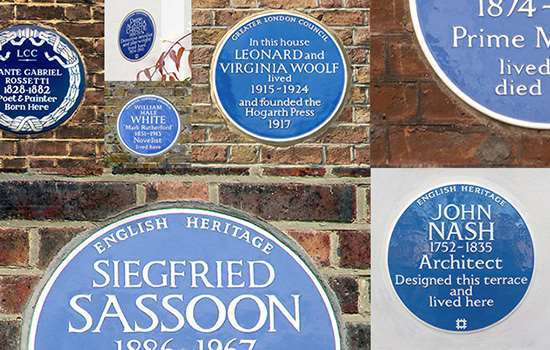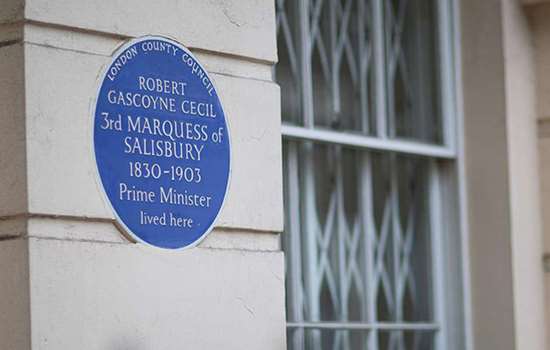HILL, Octavia (1838-1912)
Plaque erected in 1991 by English Heritage at 2 Garbutt Place, Marylebone, London, W1U 4DS, City of Westminster
All images © English Heritage
Profession
Housing and Social Reformer
Category
Architecture and Building, Philanthropy and Reform
Inscription
OCTAVIA HILL 1838-1912 Housing Reformer Co-founder of The National Trust began her work here
Material
Ceramic
Octavia Hill was one of the three founders of the National Trust and a social reformer who worked to improve housing conditions for the urban poor. She is commemorated with a plaque at 2 Garbutt Place, Marylebone, where she began her first housing scheme in 1865.
HOUSING REFORM AND SOCIAL WORK
Octavia Hill came from a family of radical thinkers and reformers in the fields of health, housing and education. She was exposed to the realities of urban poverty in 1852 while working at the Christian Socialist Ladies’ Guild near Fitzroy Square, where her mother, Caroline, was the manager. The Christian Socialists Octavia met there, including FD Maurice and Edward Vansittart, were an early influence on her, as was Henry Mayhew’s recent survey of London Labour and the London Poor. At this time she also met the artist and social critic, John Ruskin, with whom she developed an important friendship.
In 1861 Caroline Hill and her daughters set up a girls’ school at their home in Nottingham Place, Marylebone (now gone). While living there Octavia convinced Ruskin to purchase the lease of three small terraced houses in order to provide improved housing for the poor. The houses – in nearby Paradise Place, as Garbutt Place was then known – were almost new but Hill recalled that the drains were blocked and they ‘swarmed with vermin’. They were cleaned and renovated, and she managed the tenements herself, on condition that they returned a small profit on Ruskin’s investment. The tenants were to be ‘improved’ through ‘training’ by her predominantly female force of housing managers, as an early form of social work. In the 1860s, she began two further slum projects locally.
By the end of her career Octavia Hill was managing the housing of some 3,000 to 4,000 people across London. She demonstrated that small-scale model housing schemes were possible without wholesale demolition or eviction and that ‘you cannot deal with the people and their houses separately’. A tireless and skilful campaigner, Hill’s method was adopted elsewhere in Britain and abroad. The Chartered Institute of Housing is a descendant of her scheme and her name and work lives on in Octavia Housing.
OPEN SPACE CAMPAIGNS AND THE NATIONAL TRUST
Octavia Hill was a founder member of a number of other pioneering movements, notably those concerned to protect open space and to maintain access for all. These included the Commons Preservation Society (now the Open Spaces Society), established in 1865, and the Kyrle Society, a joint enterprise launched by Hill’s sister Miranda in 1876 to bring ‘beauty home to the people’. In addition to beautifying the homes of the poor, the society preserved disused graveyards as ‘open-air summer sitting rooms’ and formed larger grounds, including Vauxhall Park, for the benefit of the people.
Octavia also successfully campaigned to protect Parliament Hill and Hampstead Heath from development, and foresaw the value of a green belt in her 1888 article, ‘More Air for London’.
This work culminated in 1894 with the creation of the National Trust for Places of Historic Interest or Natural Beauty, which Hill founded together with Robert Hunter and Canon Hardwicke Rawnsley. As Hill wrote in 1907, the National Trust sought to protect the diminishing countryside for the ‘enjoyment, refreshment, and rest of those who have no country house’.
In 1890 Hill moved from Nottingham Place to 190 Marylebone Road (which no longer stands), where she died in 1912. She is buried with her sister Miranda and companion Harriot Yorke in the parish churchyard at Crockham Hill in Kent,.
Among Hill’s ‘fellow workers’ in housing reform to be commemorated with blue plaques are Henrietta Barnett and Emma Cons.
Read more about Octavia Hill at the Oxford Dictionary of National Biography.
Nearby Blue Plaques
More About Blue Plaques



